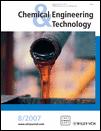Flow Regime Transitions in an Internal-Loop Airlift Reactor
Abstract
The flow regime transitions of the riser and downcomer in an internal-loop airlift reactor are investigated. Analysis of the effects of mean value, standard deviation and chaotic time series on pressure fluctuation signals is recorded to determine the transition of the hydrodynamics in the riser and downcomer of the internal-loop airlift reactor. Two major chaotic invariants, the correlation dimension and the largest Lyapunov exponent, are employed to indicate the regime transitions. The regime transitions are determined by the sudden increase and decrease of the chaotic invariants, which are computed by the pressure fluctuation signals obtained by varying the gas flow velocity. The determination of chaotic invariants predicts that there is no heterogeneous phase existing in the downcomer of the internal-loop airlift reactor. The experimental observations agree well with the predicted results.




